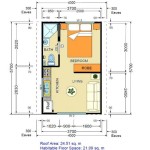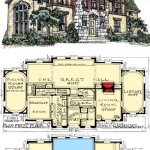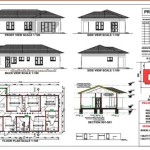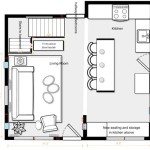Sea Container Home Plans: A Comprehensive Guide
Sea container homes, also known as shipping container homes, have emerged as a popular alternative housing solution. Their robust structure, affordability, and potential for customization make them an attractive option for individuals seeking unique and sustainable living spaces. This article explores the key aspects of sea container home plans, from conceptualization to construction.
Planning and Design Considerations
Careful planning and design are crucial for a successful sea container home project. Several factors must be considered before initiating the build:
1.
Container Selection:
Choosing the right container type and size is paramount. Standard sizes include 20-foot and 40-foot lengths, with variations in height and width. The container's condition, such as whether it's a "one-trip" container or used, will impact cost and required refurbishment.2.
Site Selection and Preparation:
The chosen location influences the foundation design, utility connections, and local building codes. Adequate site preparation, including leveling and foundation construction, is essential for structural stability.3.
Climate Control:
Containers are susceptible to temperature fluctuations. Incorporating appropriate insulation, ventilation, and heating/cooling systems is essential for comfortable living in varying climates.4.
Building Permits and Regulations:
Sea container homes are subject to building codes and regulations like traditional homes. Obtaining the necessary permits and approvals from local authorities is a crucial step in the planning process.5.
Budgeting:
Developing a realistic budget is vital. Costs include container purchase or rental, site preparation, modifications, insulation, interior finishes, and professional fees (architect, engineer, contractor).Architectural Design and Layout
The versatility of shipping containers allows for a wide range of architectural styles and layouts. Creativity and careful consideration are essential in this stage:
1.
Single vs. Multiple Containers:
Single container homes are suitable for smaller dwellings, while multiple containers can be combined to create larger, more complex structures.2.
Container Modification:
Cutting and modifying containers requires specialized equipment and expertise. Precise planning is essential to ensure structural integrity and achieve the desired design.3.
Interior Layout and Space Optimization:
Maximizing space utilization is key, especially in smaller container homes. Thoughtful space planning, including furniture placement and storage solutions, contributes to a functional and comfortable living environment.4.
Window and Door Placement:
Strategically placed windows and doors maximize natural light and ventilation. Consider the views and prevailing winds when planning their location.Construction and Modification
The construction phase involves transforming the shipping container into a habitable dwelling. Several critical steps contribute to a successful build:
1.
Foundation:
A solid foundation is crucial for stability. Options include concrete slab, pier and beam, or even shipping container foundations, depending on the site and design.2.
Insulation and Weatherproofing:
Effective insulation protects against temperature extremes and moisture. Various insulation materials can be used, including spray foam, rigid foam boards, and mineral wool.3.
Interior Finishes:
Interior walls, flooring, and ceilings can be finished with various materials, including drywall, wood paneling, tile, and laminate flooring.4.
Plumbing and Electrical Systems:
Installing plumbing and electrical systems requires professional expertise and adherence to building codes. Consider water supply, drainage, and electrical load requirements.5.
Exterior Cladding:
Exterior cladding, such as siding, metal panels, or stucco, protects the container from the elements and enhances the aesthetic appeal.Sustainability and Eco-Friendliness
Sea container homes offer several sustainable advantages:
1.
Repurposing Existing Materials:
Utilizing existing shipping containers reduces the demand for new building materials, minimizing environmental impact.2.
Reduced Construction Waste:
Container homes can generate less construction waste compared to traditional building methods.3.
Potential for Off-Grid Living:
Sea container homes can be designed for off-grid living by incorporating solar panels, rainwater harvesting systems, and composting toilets.Cost Considerations
The cost of a sea container home varies significantly depending on several factors:
1.
Container Size and Condition:
The size and condition of the container play a significant role in the initial cost.2.
Level of Customization:
Extensive modifications and high-end finishes increase the overall cost.3.
Location and Labor Costs:
Local labor costs and transportation expenses can significantly influence the project budget.4.
DIY vs. Professional Construction:
Engaging professional contractors typically adds to the cost, but ensures quality and adherence to building codes.Maintenance and Longevity
Proper maintenance ensures the longevity of a sea container home:
1.
Rust Prevention:
Regular inspection and treatment of rust are essential, especially in coastal or humid environments.2.
Insulation Integrity:
Maintaining the integrity of the insulation helps regulate temperature and prevent moisture problems.3.
Structural Integrity:
Periodic inspections of the structural components are crucial for ensuring long-term stability.
9 Container Home Floor Plans That Maximize Space House

20 Foot Container Home Floor Plans

8x20 Container Floor Plans House Building A Home

Container Home Plans Blueprints Housing

6 Bedroom Container Home Floor Plans

Container Home 6 Floorplan Design Plans House

Design Your Own Container Home Start Now Premier Box

Floor Plans Container Homes Pop Up S

Container Home Plans Cmg Containers

Affordable Housing Container Home Plans








